08-15-Daily AI News Daily
AI Daily Digest 2025/8/15
AI News|Daily Morning Read|All-Net Data Aggregation|Frontier Science Exploration|Industry Free Voice|Open Source Innovation Power|AI and Human Future| Access Web Version↗️
Today’s Summary
Visual Studio Copilot has upgraded to semantic search, and Google Gemini is now deeply integrated into VS Code.
Kimi is set to launch a PPT generation feature, while the new nano-banana model excels in image editing.
UnMarker, an open-source tool, can remove AI watermarks, sparking thoughts on tech offense and defense.
ByteDance and Tencent have open-sourced an Agent model and an interactive game video generation framework, respectively, giving back to the community.
The academic community has proposed the first paper-to-video agent system, continuously expanding AI application scenarios with innovation.Product & Feature Updates
- Visual Studio Copilot Chat got a massive brain upgrade, ditching the old BM25 keyword matching for smart remote semantic search tech 🚀. This means it truly gets what you’re trying to do. If you search “get user credentials,” it’ll find a function named “RetrieveOAuthCredential” instead of just dumbly matching words. This leap makes code search crazy accurate and efficient. Devs can spend less time “treasure hunting” and more time building awesome stuff. Wanna dive deep?
Click here to check out this in-depth (AI News) report
.
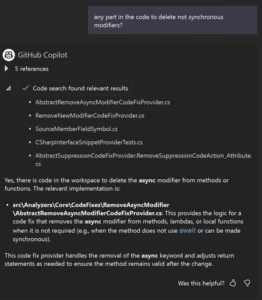

- Kimi, Moonshot AI’s gem, is about to drop its global PPT generation feature, powered by the mighty K2 model! Get ready for a productivity revolution, folks 🎉! This MoE (Mixture of Experts) model, boasting trillions of parameters, has been slaying it in code, math, and Agent tasks, and it’s set to elevate PPT creation to new heights. Say goodbye to all-nighters tweaking formats and content; the future of smart office is waving at us. For more deets, check out
this cutting-edge (AI News) report
.

- Nano-banana, a mysterious model, just popped up on the lmarena platform and is already blowing minds with its “insanely good” image editing results 🔥! Early users are raving that it outperforms the highly acclaimed FLUX Kontext in three core areas: character restoration, scene reconstruction, and image fusion. This dark horse is signaling a new era of powerful creative tools for graphic design, film post-production, and beyond. Go
experience this new (AI News) product
yourself!
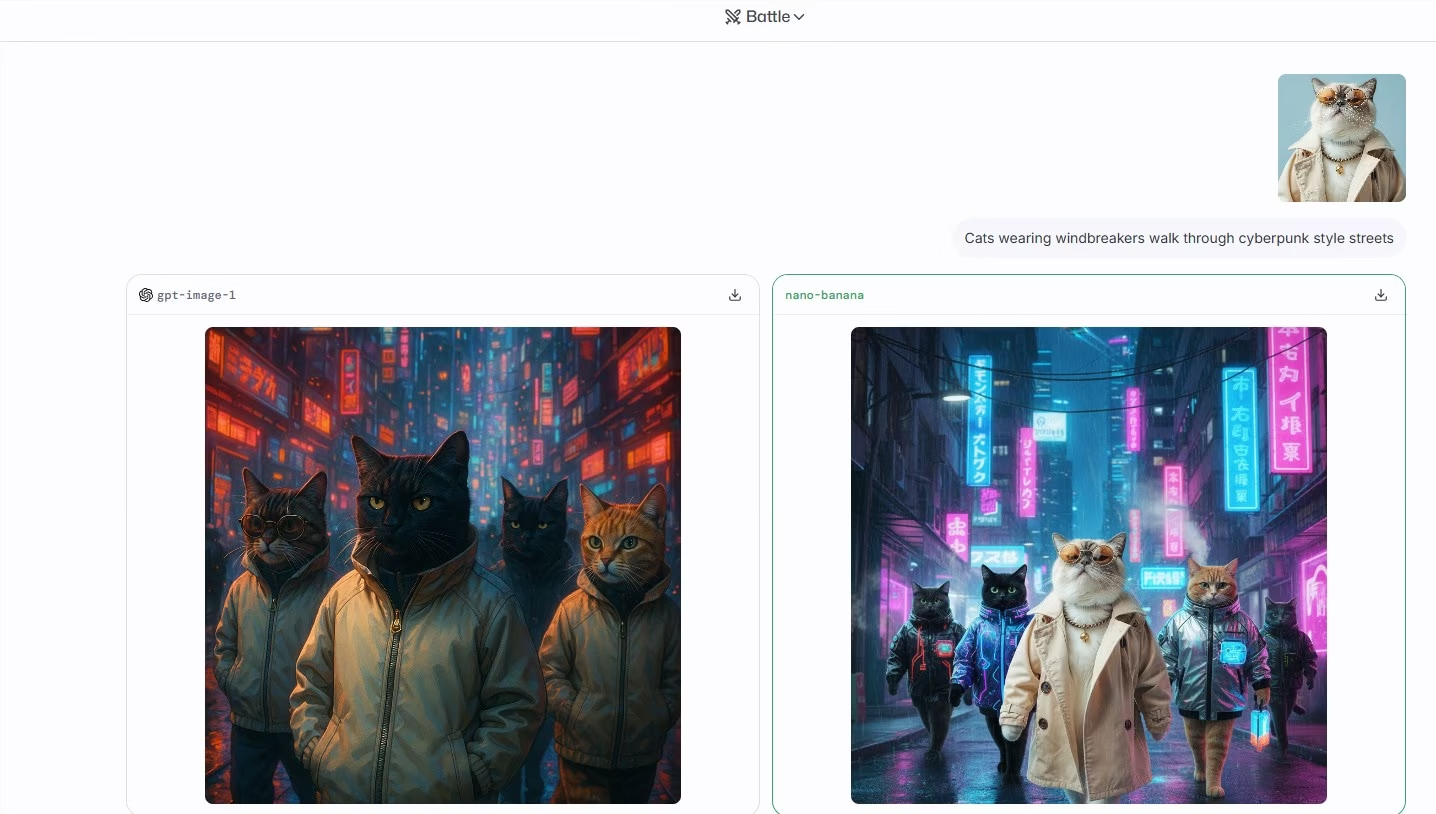
- Google’s Gemini CLI tool is now officially super integrated with VS Code, giving devs a seamless, smart coding experience 💡. You can now get context-aware, intelligent suggestions directly from Gemini right inside your editor and easily review and apply changes with the native diff feature. This integration seriously streamlines the dev workflow, making coding way smoother and more efficient. For all the deets, check out this official (AI News) announcement .
- Tongyi Qianwen’s new image editing feature, Qwen Image Edit, is still cooking, but the official team couldn’t resist dropping a “spoiler” with a cute capybara test image (o´ω’o)ノ! This Qwen capybara, covered in all sorts of stickers, perfectly showcases the new tool’s creative potential, making us hyped for its future photo editing and creation capabilities. Looks like content creators are getting a new toy soon, so let’s all anticipate
the release of this (AI News) tool
!
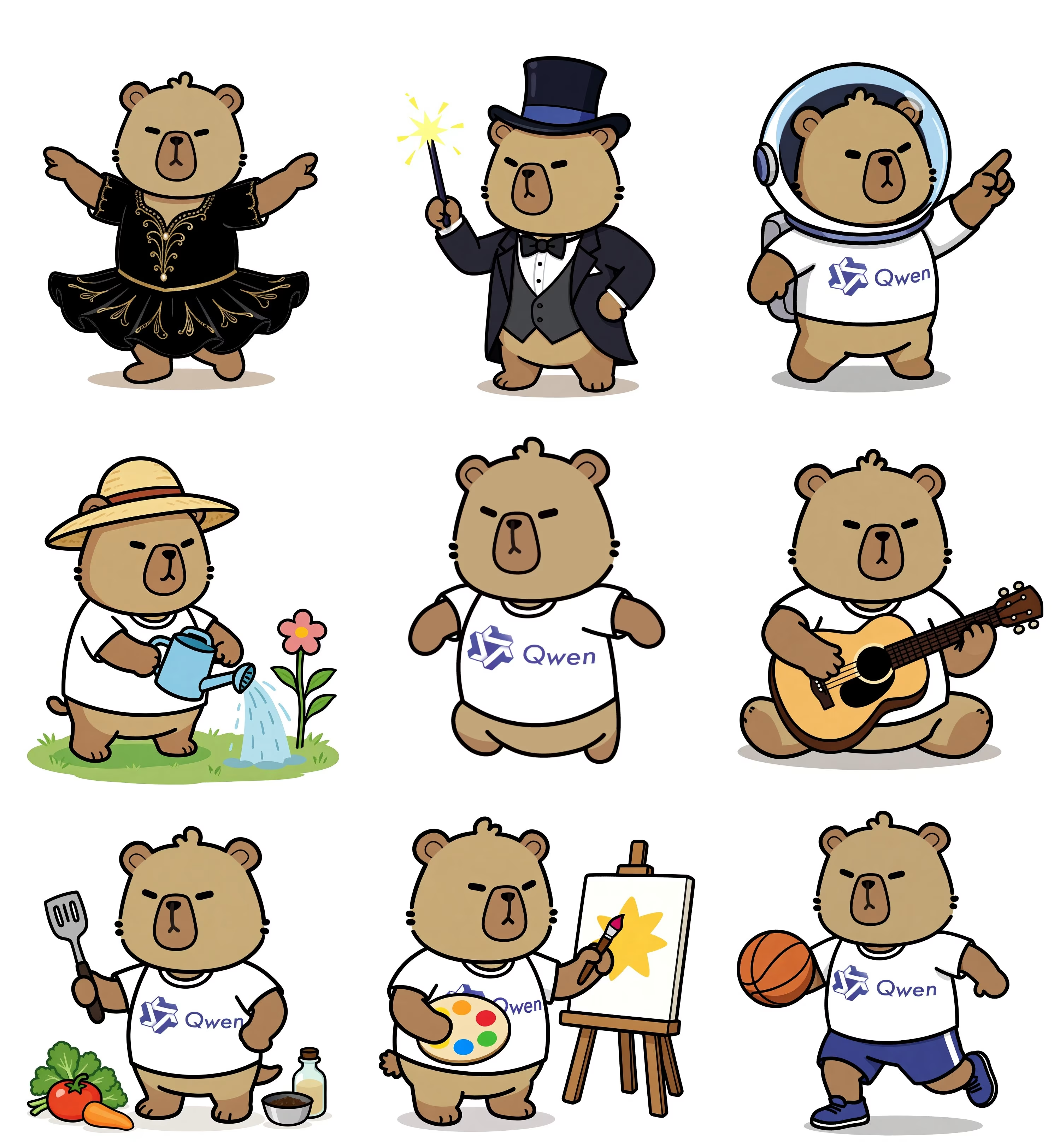
Cutting-Edge Research
- ViewDelta, a new research (AI News) , has dropped a brilliant solution to the headache traditional scene change detection methods face with their ambiguous “relevant change” definitions 💡. Researchers introduced a text-conditioned framework that lets users define exactly what changes to detect using natural language prompts, like “only changes in buildings” or “ignore vegetation growth.” This method not only solves the inconsistent dataset labeling problem but also trains a general model adaptable to various scenarios—talk about hitting the bullseye every time 🎉!
- Preacher, a new research (AI News) , is here to completely solve the problem of turning a dry academic paper into a lively, engaging video summary 🤔! This system acts like a pro “preacher,” first breaking down and distilling the paper’s core ideas top-down, then generating diverse video segments bottom-up and compiling them into a coherent video abstract. Thanks to its innovative Progressive Chain of Thought (P-CoT) technique, it has successfully overcome the limitations of current video generation models, making knowledge dissemination more intuitive and efficient than ever.
- CopilotLens, a new research (AI News) , is working to crack open the “black box” of AI coding assistants, which often leave developers feeling uncertain about their code suggestions. Researchers designed a novel interactive explanation framework that acts like a “lens,” visualizing the AI assistant’s “thought process” and clearly showing the source and logic behind its code suggestions. This framework aims to help developers better understand and trust AI’s recommendations, moving from “blind acceptance” to “critical collaboration,” making human-AI collaborative programming more transparent and reliable 🧐.
Industry Outlook & Social Impact
- UnMarker, an open-source tool, is shattering the “moat” of AI image watermarks, wiping out nearly all invisible watermarks on the market in just 5 minutes with a consumer-grade GPU – even Google’s SynthID isn’t safe 🔥! It doesn’t crack the watermark algorithm; instead, it directly messes with the image’s spectral characteristics, essentially pulling the rug out from under the watermark to render it useless. This game-changing discovery comes from
this cutting-edge (AI News) report
. This undoubtedly poses a huge challenge to efforts relying on watermarking for content traceability and combating fake info, sparking some deep thoughts about tech offense and defense 🤔.

- DreamAI, a concept introduced in a thought-provoking Reddit (AI News) post , makes creating and exploring virtual worlds directly with your thoughts no longer just sci-fi material 🧠. This idea combines Google’s Genie 3 (real-time text-to-3D world generation) with brain-computer interfaces (thought-to-text) to let users instantly generate and change VR environments with their minds. This won’t just unlock new interaction dimensions for people with disabilities; it could totally revolutionize how we create, entertain, and even explore our own imaginations. The future is here 🎉!
Open Source TOP Projects
- ByteDance just dropped a major new player for the open-source community: the M3-Agent-Control model, built specifically for Agents and trained on the powerful Qwen3-32B, boasting a whopping 32.8 billion parameters (o´ω’o)ノ! This project aims to be the core engine driving the next generation of intelligent agents, accelerating AI Agent tech innovation and adoption through open sharing. ByteDance is inviting developers worldwide to explore the limitless potential of intelligent agents. If you’re curious, quickly go
check out this (AI News) project on Hugging Face
!
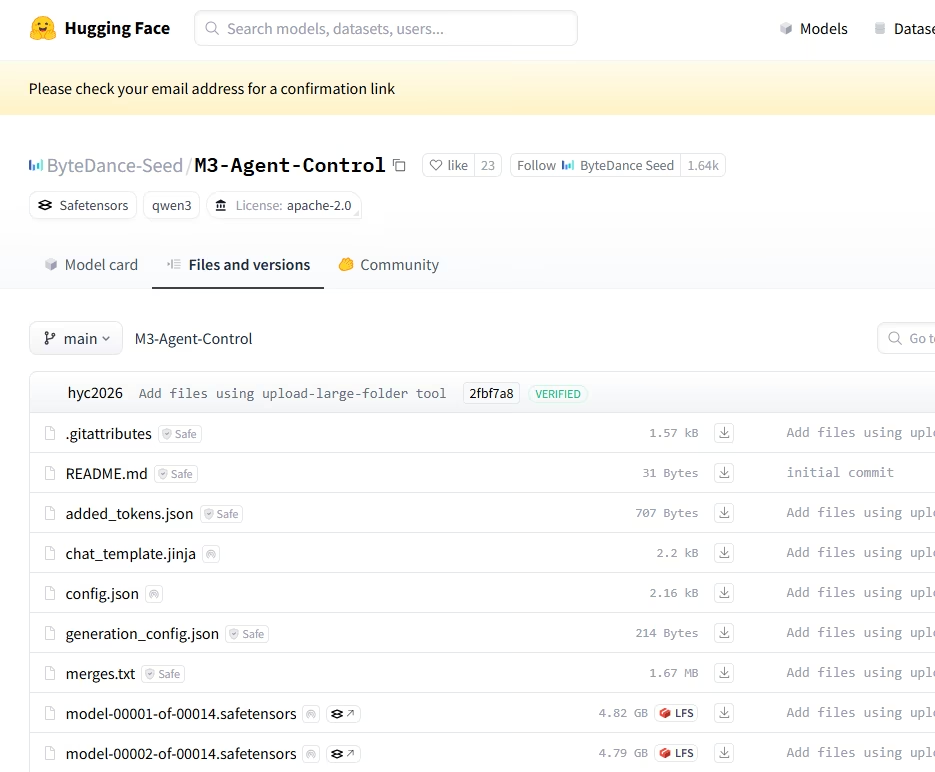
- Tencent Hunyuan Team’s open-source project, Hunyuan-GameCraft (⭐1k+), makes it possible to turn a static image into a playable AAA-level game blockbuster, thanks to its innovative highly dynamic interactive game video generation framework 🎮! This project lets users generate smooth game videos with free camera movement in real-time using just one image, a few lines of text, and simple action commands, drastically lowering the barrier and cost for game content production. It’s not just a godsend for game developers; it also opens up a whole new world for video creators. Go
explore this hot (AI News) project on GitHub
!
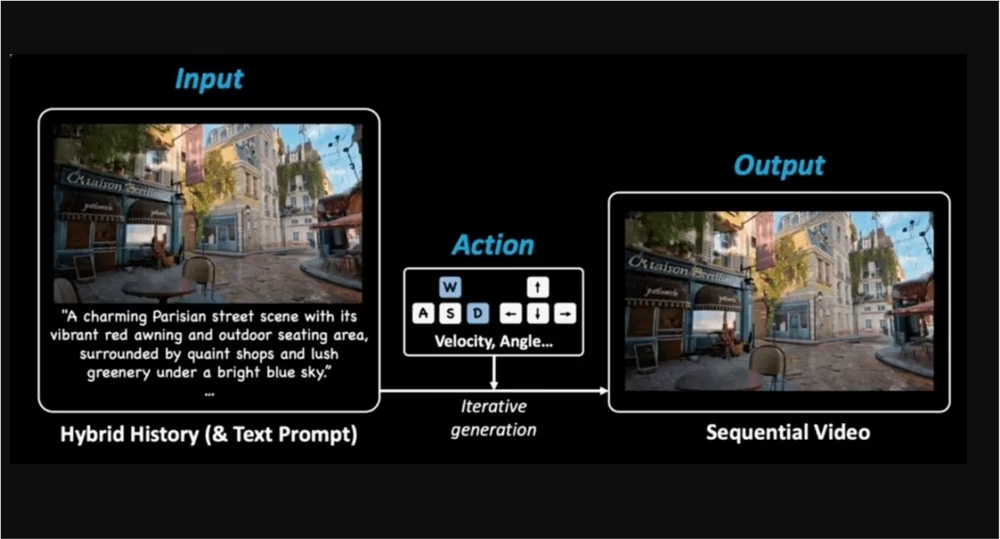
- Pathway, a project that’s already bagged ⭐31.1k stars on GitHub, is a powerful Python ETL framework built specifically for stream processing, real-time analytics, and RAG 🚀. Still stressing over real-time data processing and complex LLM application pipelines? You gotta check this out! This tool makes building efficient, scalable data pipelines incredibly simple. Whether you’re dealing with real-time event streams or setting up intricate AI applications, it handles everything like a champ. If you wanna level up your data processing game, why not start with this super cool (AI News) project ?
- Netflix’s open-source project, Conductor (⭐25.4k), is an event-driven orchestration platform born to be that stable, reliable “conductor” for complex applications and microservices 🎶. It provides a persistent and highly resilient execution engine for your apps, ensuring workflows run flawlessly in all scenarios. If you’re on the hunt for a solution that can master complex business processes, then this powerful (AI News) orchestration tool is absolutely worth a deep dive.
- Ai-toolkit (⭐5.7k) project has got your back, offering a one-stop ultimate training toolkit that makes fine-tuning your diffusion models as easy as pie 🔥. Want to fine-tune your own diffusion model but intimidated by complicated training processes? Don’t sweat it! This wildly popular toolset on GitHub encapsulates all the tricky training details, letting you focus purely on bringing your model ideas to life. Go check out this (AI News) project that will ignite your creativity !
- COLMAP (⭐9.2k) project offers a complete and powerful toolchain for Structure from Motion (SfM) and Multi-View Stereo (MVS), covering everything from 3D reconstruction to scene understanding 📸. It can accurately reconstruct realistic 3D models and scenes from a series of 2D images, making it an essential weapon for computer vision researchers and engineers. If you’re curious about 3D vision tech, then this hardcore (AI News) open-source project is an absolute must-see.
- YTSage (⭐1.4k) project is here to refresh your YouTube downloading game, bringing a breath of fresh air with its modern, sleek PySide6-built interface that offers an awesome experience (o´ω’o)ノ! Sick of bloated, outdated YouTube downloaders? This tool, based on the reliable yt-dlp, not only supports downloading videos in any quality and extracting audio but also integrates thoughtful features like subtitle retrieval and ad blocking (SponsorBlock). If you want an elegant yet powerful video downloading experience, hurry up and give this practical (AI News) tool a try!
Social Media Shares
- Alibaba Tongyi Qianwen’s Qwen-3-235B-A22B-Instruct model just clinched the top spot on the August open model leaderboard, once again proving its peak prowess 🎉! The battle of the titans in the open-source large model arena is heating up. Meanwhile, Zhipu’s GLM-4.5 and OpenAI’s gpt-oss-120b also made a grand entry into the top ten, putting on an epic show of “immortal combat.” This clash of technological giants is pushing the entire industry forward at warp speed. Go
check out the latest (AI News) leaderboard
!

- MuleRun, an Agent product from overseas, is currently making waves with its unique concept and jaw-dropping results: it provides a full virtual machine for each user to run their Agents, instantly exploding the imagination 🚀! This means AI Agents aren’t just stuck in browsers or the Office suite anymore; they can automatically play games, model in Blender, truly enabling cross-software automation. This community-driven model of packaging professional tasks into callable Agents might just be pointing towards a brand new evolutionary direction for Agent products. Go
check out this super futuristic (AI News) share
!
- ChatGPT Team and Enterprise editions’ usage limits got you scratching your head? The official team finally dropped a detailed FAQ, clearly outlining the specific usage counts for models like GPT-5 and GPT-4o, with this (AI News) post giving a clear summary 🧐. For instance, Team edition users can make 200 GPT-5 reasoning requests daily, while Enterprise users get 200 weekly. This info is super critical for power users to plan their strategies. What’s cool is that the official statement says current GPT-5 limits are temporary and might get looser in the future, which is something to look forward to!
- Perplexity’s AI browser Comet offers a new trick: tired of manually refreshing X (Twitter) to keep up with the latest from overseas AI bigwigs? A netizen shared a cool new way to use prompts to have AI automatically “scroll X” for you and translate/summarize key info 🔥. This “AI helping you get AI news” inception-like operation is not only super efficient but also tons of fun, perfectly showcasing the massive potential of AI Agents in information retrieval. If you want to free up your hands, why not learn
this fun (AI News) trick
?
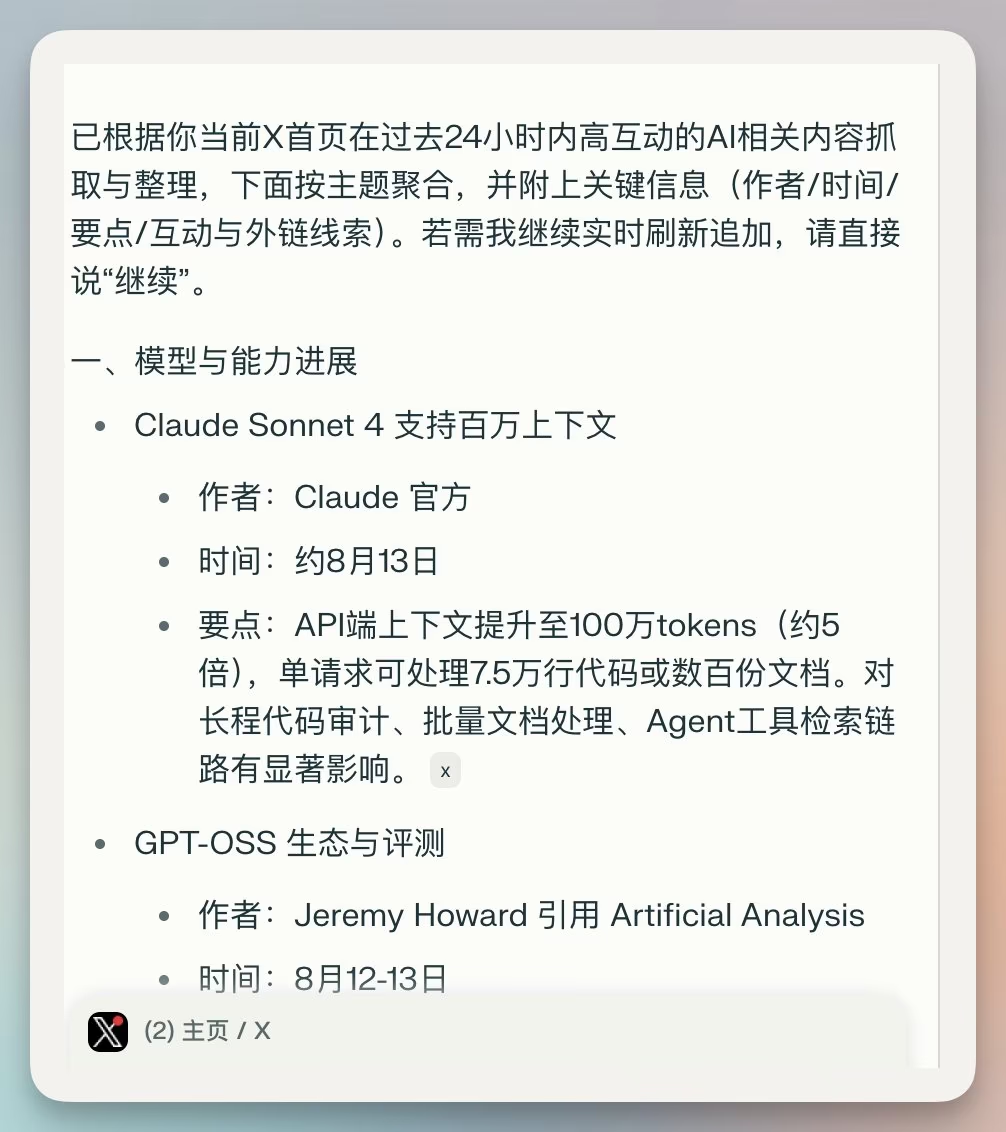
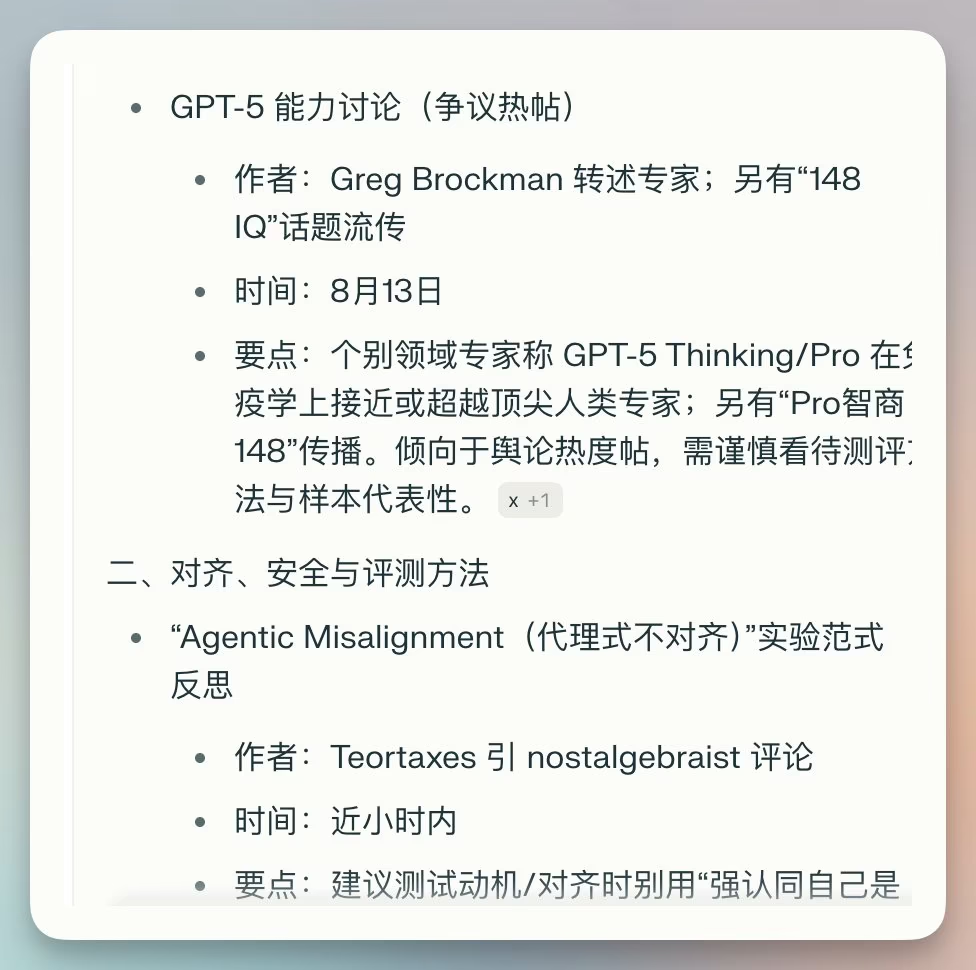
- Claude Opus 4.1’s “OCD” is no joke! A developer shared his mind-blowing experience: the model iterated 39 whole versions just to write one paginated HTML, showing an absolutely insane dedication to perfection 🤯. This case vividly demonstrates top-tier large models’ obsession with code perfection and gives us a glimpse into AI’s immense potential for meticulous work. To get a sneak peek,
click this amazing (AI News) share
.

- A netizen shared a killer trick for getting models to master professional knowledge: maybe you’re just not “training” AI correctly if you’re still complaining it’s dumb 💡. The secret? Use AI to break down professional books, extract methodologies, then feed them to an Agent via few-shot examples. This process is like AI “apprenticing,” allowing it not only to imitate but also to understand and practice, thereby fooling 60% of people. This idea offers valuable insights for building more professional AI Agents. Go learn this practical (AI News) tip !
- A simple but absolutely crucial tip for communicating with large models is to focus on “what to do” rather than “what not to do,” as highlighted by this (AI News) share 🤔. Negative instructions (like “don’t write run-on sentences”) often distract the model, making it more prone to errors, while positive instructions (like “please check grammar sentence by sentence”) guide it more clearly toward the desired outcome. This tiny shift, just like communicating with humans, can hugely boost the efficiency and quality of your AI collaboration.
- A netizen dropped a point that’s both profound and slightly chilling: Have you ever considered that future AI might know you better than you know yourself 😨? AI can remember countless details long forgotten by humans, and it could “roast” you with your chat history from years ago – sounds pretty terrifying, right? This thought reminds us that while embracing the convenience AI brings, we must also confront the privacy and social implications of its powerful memory and analytical capabilities. For more intriguing insights, check out
this thought-provoking (AI News) post
.

AI Product Spotlight: AIClient2API ↗️
AIClient-2-API is your ultimate solution if you’re sick of jumping between AI models and getting bogged down by annoying API rate limits 🎉! It’s not just a regular API proxy; it’s a magic box that can “turn lead into gold,” transforming tools like Gemini CLI and Kiro client into powerful OpenAI-compatible APIs.
The core charm of this project lies in its “reverse thinking” and powerful features:
✨ Client-to-API Transformation Unlocks New Possibilities: We’ve cleverly leveraged Gemini CLI’s OAuth login to let you easily break through official free API rate and quota limits. Even more exciting, by encapsulating Kiro client interfaces, we’ve successfully “cracked” its API, allowing you to call the powerful Claude model smoothly for free! This offers you an “economical and practical solution for programming development using free Claude API plus Claude Code.”
🔧 System Prompt Management is Totally in Your Control: Want AI to listen better? We’ve got powerful System Prompt management features. You can easily extract, overwrite, or append system prompts in any request, fine-tuning AI’s behavior on the server side without even touching your client code.
💡 Top-Tier Experience at a Commoner’s Cost: Imagine this: using Kiro code assistant in your editor, paired with Cursor’s efficient prompts, then hooking it up with any top-tier large model—why even bother with Cursor when you’ve got this? This project lets you combine tools to get a dev experience comparable to paid ones, all at an incredibly low cost. Plus, it supports MCP protocol and multimodal inputs like images and documents, so your creativity knows no bounds.
Say goodbye to tedious configurations and hefty bills, and embrace this new AI development paradigm that’s free, powerful, and flexible all in one!
AI News Daily Audio Version
| 🎙️ Xiaoyuzhou FM | 📹 Douyin |
|---|---|
| Afterlife Tavern | Self-Media Account |
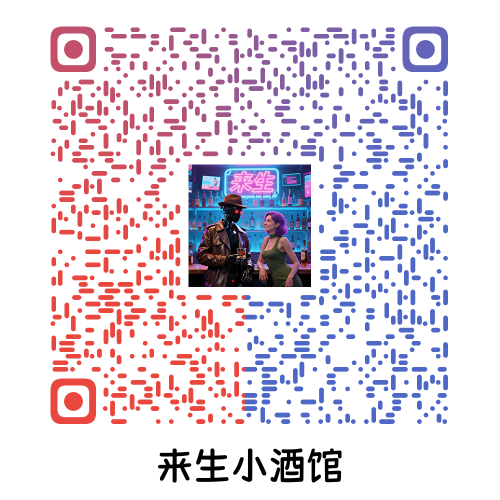 | 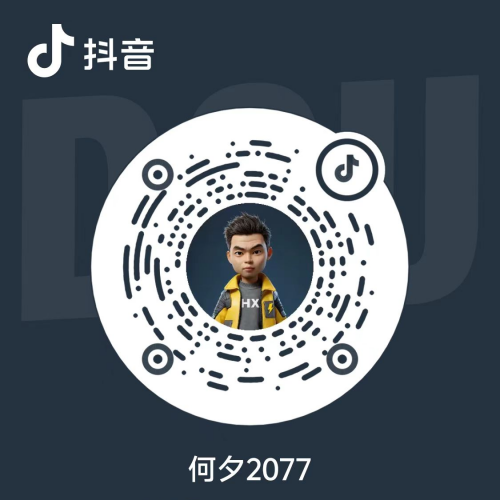 |
AI Sci-Fi Novel - “The Gazers”
Chapter 13: The Gazers’ Destiny
Time: Eight Years After the Pandora Incident
Lin Yao watched the autumn rain gently tap against the huge glass dome of her research center. Below the dome, a climate-controlled indoor ecological garden mimicked a tropical rainforest. As she paused her wheelchair, she quietly observed the rainwater gathering into streams on the glass, winding its way down. This natural, complex, and unpredictable pattern always soothed her turbulent thoughts. The “Echoes of the Abyss” incident was a year behind them. The “Star Capsule” craze had faded, and the world seemed to have returned to normal. Lin Yao’s proposed education reform suggestions, like a pebble dropped into a deep pond, had stirred ripples, but shaking the bedrock of the entire education system remained a long and arduous journey.
Life, for Lin Yao, seemed to have settled into a quiet rhythm. Researching, advocating, and safeguarding the “Gazers” – that was her daily routine. Until the letter arrived.
The letter was handwritten, sent from a psychiatric asylum in a remote mountainous area. The handwriting, sometimes neat and graceful, sometimes wild and scrawled, seemed to belong to two entirely different people. The signature was a name Lin Yao found both familiar and strange: Lin Mo. It was her father’s name.
Lin Yao’s father, once one of the nation’s top theoretical physicists, always appeared as a silent, distant figure in her childhood memories. Unlike other fathers, he didn’t take her to parks or tell her fairy tales. He’d just sit at his desk, using symbols she couldn’t understand to build models of the universe on reams of manuscript paper. Occasionally, he’d point to the starry sky and, almost in a trance, tell her young self about black holes, gravitational waves, and the beginning of time. He taught her about the entire universe but never how to tie her shoelaces.
Her father “went mad” when she was fifteen. He started claiming he could “hear” whispers in the cosmic background radiation, believing they were messages from higher-dimensional civilizations. He locked himself in his room, covering the walls, floor, and ceiling with dense, incomprehensible formulas and symbols. Eventually, he was diagnosed with “paranoid schizophrenia” and committed to an asylum.
This incident was Lin Yao’s deepest pain and one of the fundamental motivations behind her initial decision to dedicate herself to gene and brain science research – she wanted to know where her father’s genius brain, which once contained the entire universe, had gone wrong. Now, after nearly twenty years, this letter from her father reappeared before her.
The letter’s content was chaotic and disjointed. Most of it consisted of wild conjectures about “anharmonic vibrations of cosmic strings,” but by the end, the handwriting suddenly became clear and tender: “Xiao Yao, I’ve seen your story. Pandora, the ‘Gazer gene’… So that’s how it is. We… are the same kind of people. I always thought it was my fault, that I had gone mad. Now I understand, this isn’t an illness; it’s our… destiny.” “…I’m running out of time. While I’m still lucid, I want to see you one last time. I want to give you my ‘model.’ It’s incomplete, but I know only you can understand it.”
Lin Yao’s hand, holding the letter, trembled slightly. The next day, she drove alone to the asylum nestled deep in the mountains. Ava Jensen was uneasy, but Lin Yao insisted on going by herself. She knew this was a buried past she had to face alone.
The asylum was as quiet as a secluded monastery. Led by the director, Lin Yao walked through a long, sun-drenched corridor, arriving at a ward. Inside the room, an old man with white hair and a withered frame sat by the window, intently watching a ginkgo tree swaying in the wind outside. He wasn’t looking at the tree itself, but at the trajectories of the falling leaves, as if searching for some chaotic mathematical pattern within them.
The old man (Lin Mo) looked up. “Lin… Yao?” When he turned his head and saw Lin Yao, a glimmer of clarity flashed in his murky but profound eyes. “Dad,” Lin Yao whispered, the word feeling so unfamiliar on her tongue.
The room held no excessive pleasantries, no embrace of a father and daughter reunited after a long separation. Lin Mo pointed to the dusty box under the bed, motioning for Lin Yao to open it. Inside the box were thousands of yellowed manuscript pages, each covered with dense formulas, charts, and symbols. This was his life’s work, the “cosmic model” that the world had dismissed as “ravings.”
Lin Mo’s voice, hoarse and faint, said, “They all said I was crazy, but I wasn’t. I just… saw things they couldn’t. Like that ancient man, Keli. We can hear whispers in our bloodline, echoes left from the birth of the universe. But this ‘hearing’ comes at a cost.” He pointed to his temple. “Here, it’s like an overclocked computer, destined to burn out one day. This is the Gazer’s destiny. We’re given eyes to see the stars, but we also bear the agony of our brains burning out.”
Lin Yao silently looked at the manuscript papers. With her current knowledge, she could see that these so-called “ravings” were not without logic. It was a… a theoretical framework built with intuition and inspiration, extremely personalized, transcending existing mathematical language. It was chaotic, incomplete, yet in certain parts, it shone with the brilliance of a genius.
Lin Yao started, “You…” wanting to ask something but not knowing where to begin. She wanted to ask, “Do you regret it? Have you resented this destiny?” Lin Mo seemed to read her mind. He smiled, a smile laced with both sadness and relief. “When I was young, I tried to be ’normal.’ I learned to love, to be a good husband, a good father.” His gaze drifted into the distance as if recalling something. “I loved your mother, and… I loved you. But I found I couldn’t do it. When I looked at you, I didn’t see my daughter; I saw the atoms that made you, the beautiful double helix in your genes… it was my damned analysis and calculation that I couldn’t stop.” “My love was also a form of ‘pattern recognition.’ That’s just too unfair for a wife, for a daughter. So, I chose to leave, to… immerse myself in my own world. It was better for all of you.”
Lin Yao’s heart felt tightly squeezed by an invisible hand. She finally understood her father’s “coldness” and “detachment” from all those years ago. It wasn’t a lack of love, but rather… a thinking pattern he couldn’t control, one unique to a “Gazer.” His brain had “dehumanized” and “datafied” the entire world. He loved them, but he couldn’t express or feel love in a human way. Perhaps this was the “Gazer’s” deepest tragedy: not being shunned by the outside world, but internally losing the ability to forge warm connections with it.
Lin Mo’s voice grew weaker, his eyes starting to glaze over. “This model is missing one last piece,” he said. “A parameter for the ‘initial singularity’ that I could never find. I… I hid it in the only thing related to ‘people’ that I could remember.” He extended a trembling hand and pointed at Lin Yao. “Your… your birthday. Year, month, day—eight digits. Substitute them into the ‘Lin Equation’ on page 37… that’s… the key…” As soon as he finished speaking, the light in his eyes completely faded. He reverted to the old man staring blankly out the window, lost in his own world. He no longer recognized Lin Yao, nor the world around him. The string of sanity in his brain, having completed its final handover, had snapped for good.
Lin Yao sat quietly by her father’s hospital bed, tears silently streaming down her face. She wasn’t weeping for his “madness,” but because she finally understood the heavy, clumsy fatherly love that had spanned two decades, wrapped within cosmic models and chaotic symbols. He hadn’t forgotten her. He transformed his sole, deepest memory of his daughter into the key that unlocked his entire intellectual universe. This was a unique romance, one belonging only to a “Gazer.”
That night, Lin Yao entered her father’s model and the string of numbers representing her birthday into the research center’s supercomputer. The massive data began to churn. On the screen, the chaotic, incomplete cosmic model, after receiving that crucial “initial parameter,” began to self-correct, evolve, and complete itself, like a creation infused with a soul. Eventually, it stabilized, forming a perfect, self-consistent theoretical model describing the universe from its birth to its end. In the center of the screen, a message automatically generated and sent by “Adam” appeared: “He saw it. He just used a different language to describe it. Our respects to him.”
Lin Yao leaned back in her wheelchair, gazing at the perfect cosmic model, shimmering with the light of wisdom, and recalled her father’s final, relieved smile. Suddenly, she understood.
The Gazer’s destiny might be loneliness, madness, and burning out. But within this destiny, there’s still room for love. Perhaps it’s not as warm and direct as ordinary human love; it’s hidden in formulas, encoded in the trajectories of stars, given by a father through a lifetime of “madness” as a final gift to his daughter. Lin Yao stood up and walked to the massive floor-to-ceiling window. The rain had stopped, the dark clouds dispersed, revealing a clear, star-studded night sky. She knew her father hadn’t truly left. He had simply become a part of this cosmic model, one of the countless stars scattered across the sky. Like Keli, and like all lonely Gazers, their ultimate destination was the sea of stars. And she, carrying this unique “love,” would continue to protect those on the ground who were still lost, searching for their own starry skies. Because she knew that within the double helix of every genius and madman, there might just be a gentle key, capable of unlocking the entire universe.